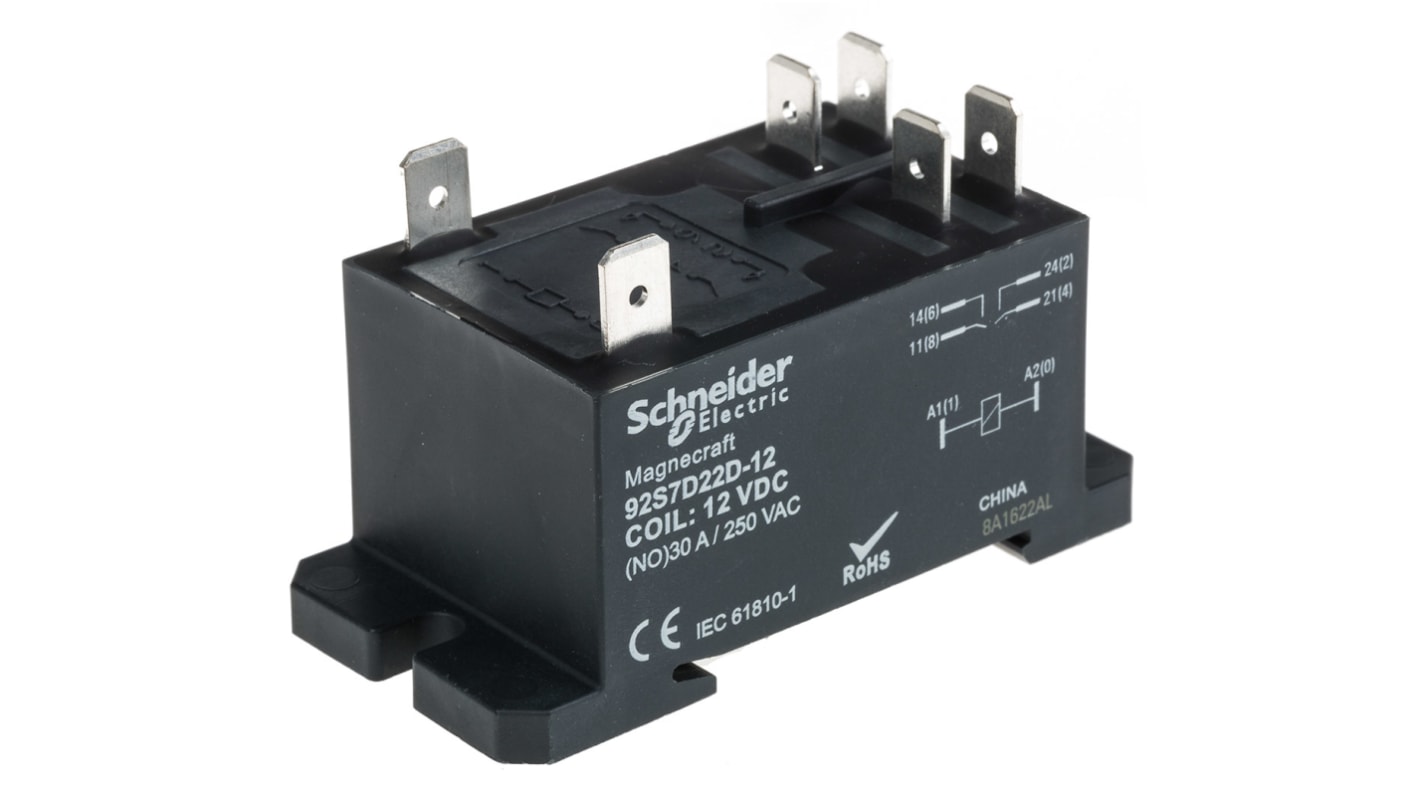Schneider Electric Panel Mount Power Relay, 12V dc Coil, 20A Switching Current, DPST
- RS Stock No.:
- 814-8462
- Mfr. Part No.:
- 92S7D22D-12
- Brand:
- Schneider Electric

Currently unavailable
We don't know if this item will be back in stock, RS intend to remove it from our range soon.
- RS Stock No.:
- 814-8462
- Mfr. Part No.:
- 92S7D22D-12
- Brand:
- Schneider Electric
Specifications
Technical Reference
Legislation and Compliance
Product Details
Find similar products by selecting one or more attributes.
Select all | Attribute | Value |
|---|---|---|
| Brand | Schneider Electric | |
| Coil Voltage | 12V dc | |
| Contact Configuration | DPST | |
| Mounting Type | Panel Mount | |
| Switching Current | 20A | |
| Number of Poles | 2 | |
| Latching | No | |
| Terminal Type | Quick Connect | |
| Maximum Switching Voltage AC | 300V | |
| Length | 33.7mm | |
| Coil Resistance | 86Ω | |
| Coil Power | 4W | |
| Isolation Coil To Contact | 4kV ac | |
| Maximum Operating Temperature | +55°C | |
| Minimum Operating Temperature | -40°C | |
| Standards Met | CE, CSA, UL | |
| Contact Material | Silver Alloy | |
| Life | 100000 cycles | |
| Height | 30mm | |
| Depth | 52mm | |
| Application | Power | |
Select all | ||
|---|---|---|
Brand Schneider Electric | ||
Coil Voltage 12V dc | ||
Contact Configuration DPST | ||
Mounting Type Panel Mount | ||
Switching Current 20A | ||
Number of Poles 2 | ||
Latching No | ||
Terminal Type Quick Connect | ||
Maximum Switching Voltage AC 300V | ||
Length 33.7mm | ||
Coil Resistance 86Ω | ||
Coil Power 4W | ||
Isolation Coil To Contact 4kV ac | ||
Maximum Operating Temperature +55°C | ||
Minimum Operating Temperature -40°C | ||
Standards Met CE, CSA, UL | ||
Contact Material Silver Alloy | ||
Life 100000 cycles | ||
Height 30mm | ||
Depth 52mm | ||
Application Power | ||
- COO (Country of Origin):
- CN
Schneider Electric Non-Latching Relay, 2 Poles, 20A Switching Current - 92 Series - 92S7D22D-12
Need a heavy-duty power relay for use in demanding environments? This non-latching relay from Schneider Electric has a robust lifespan of 100,000 cycles, making it a long-lasting and reliable choice. It can switch currents of 30A at voltages up to 300V AC, so it can handle high-power applications. Thanks to its wide operating temperature range of -40°C to +55°C, it's suitable for use in a variety of demanding environments. It measures only 33.7 (length) x 30 (height) x 52mm (depth), so can be used in setups where space is limited.
Features & Benefits
• Coil-to-contact isolation of 4kV AC for greater electrical safety
• Cover attaches directly onto a panel or DIN rail for simple mounting
• Quick-connect terminals for ease of installation
• Silver-alloy contact material ensures high conductivity and corrosion resistance for a reliable connection
• Cover attaches directly onto a panel or DIN rail for simple mounting
• Quick-connect terminals for ease of installation
• Silver-alloy contact material ensures high conductivity and corrosion resistance for a reliable connection
Applications
• Automotive engines
• Aircraft controls
• Industrial machinery
• Aircraft controls
• Industrial machinery
What's the difference between a non-latching relay and a latching relay?
When power is removed from a circuit, a non-latching relay will return to its original position, while a latching relay will remain in the last position. That makes non-latching relays like this one a good choice for temporary switching applications.
